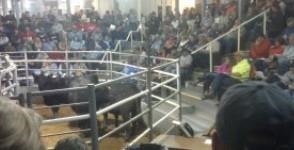Michael Oosten’s grandparents were dairy farmers in the Netherlands and immigrated to California in the 1920s, starting their own dairy farm in Paramount in 1945 before moving to larger farms in Artesia and Bellflower.
In the early 1970s, they moved their farm to Chino, but decided to sell it in 2001 to a trucking company located next to an Amazon warehouse, which was built on land consisting of two other dairy farms.
Oosten, who for 18 years has owned Marvo Holstein’s dairy farm in Lakeview, which supplies milk to Land O’Lakes, said dairy farming has declined in California since the industry’s peak in 2008. The industry has been hurt by declining real estate in Southern California . , more affordable land in other states, strict permitting processes, and scarcity of water and other natural resources.
“Economics is the biggest driver of farmers leaving the country to go out of state,” Oosten said. “Milk prices tend to be very competitive in other states; feed prices are lower and the regulatory environment is better.”
Real estate in particular has played a significant role in more dairies choosing to leave California, he said.

Michael Oosten on his family’s dairy farm in Lakeview, California.
“As the urban sprawl came in and got close to the farm, developers would come in and buy the land and convert it into residential or commercial buildings,” he said. “That’s the evolution of what’s happened in the California dairy industry. Lately in the last 20 years, a lot of people have started moving out of state.”
Marvo Holsteins is one of about 1,200 dairies left in California, down significantly from the roughly 2,100 farms in 2001 and 20,000 farms in 1950, according to Michael Boccadoro, executive director of the sustainable nonprofit Dairy Cares.